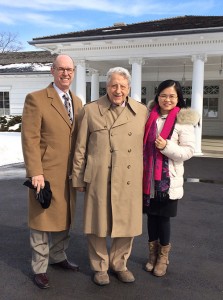 Lawrence Marnett, George Sosnovsky, Xiaohua Peng
Lawrence Marnett, George Sosnovsky, Xiaohua PengLawrence J. Marnett, PhD, is University Professor, the Director of the A.B. Hancock Jr. Memorial Laboratory for Cancer Research, Mary Geddes Stahlman Professor of Cancer Research, and Professor of Biochemistry, Chemistry, and Pharmacology. Dr. Marnett received his PhD in Chemistry from Duke University in 1973 and did postdoctoral work at the Karolinska Institute and Wayne State University. He began his academic career at Wayne State University where he rose through the ranks to Professor of Chemistry. In 1989, he accepted a position at Vanderbilt University.
Dr. Marnett’s research program focuses on the role of the enzyme cyclooxygenase-2 in cancer and inflammation as well as on the role of lipid oxidation products in DNA damage and mutation. His group has used structure-based based approaches in conjunction with medicinal chemistry to design selective cyclooxygenase-2 inhibitors as potential anti-inflammatory, cancer preventive, and imaging agents. He is the author of over 450 research publications and 14 patents. Among the many awards, Prof. Marnett received the American Cancer Society Faculty Research Award, the Sigma Xi Research Award, an Outstanding Investigator Award, a MERIT Award from the National Cancer Institute, the Founders Award from the American Chemical Society Division of Chemical Toxicology, and the George and Christine Sosnovsky Award for Cancer Research from the American Chemical Society. He is a Fellow of the American Association for the Advancement of Science and a Fellow of the American Chemical Society.
Prof. Marnett is a charter member of the ISSX and served on the Finance Committee from 1996-1999. He was the founding Editor-in-Chief of Chemical Research in Toxicology, a position that he held for 25 years. He has served on numerous editorial advisory boards, grant review committees and service committees of scientific societies. Dr. Marnett served as Associate Director of Basic Research of the Vanderbilt Ingram Cancer Center from 1993-2002 and is currently Director of the Vanderbilt Institute of Chemical Biology.
His first lecture presented on Thursday 6th 2014 was titled:
Targeting Cyclooxygenases as a Strategy for Improved Cancer Detection and Therapy
Significant reductions in mortality from cancer have been made in the past 25 years principally from reduced smoking and improved detection methods. Some notable achievements have been made in treating particular cancers but major breakthroughs in the treatment of most solid tumors remain elusive. The onset of molecularly targeted therapies offers hope for future advances but the heterogeneity of most late-stage tumors will reduce their efficacy. Early detection remains the most effective way to reduce cancer mortality. Advances in molecular imaging suggest that it may be possible to detect and profile cancers early in their deverlopment using agents targeted to specific molecules expressed in the cancers. Cyclooxygenase-2 (COX-2) is an important player in inflammation and is expressed at high levels in many cancers and their precursor lesions. Thus, COX-2 is a potentially general target for imaging cancer and pre-malignancy. This lecture will describe the chemistry, biochemistry an in vivo proof-of-concept for COX-2-targeting imaging of cancer. It will also describe attempts to target COX-2 for selective delivery of chemotherapeutic agents.
His second lecture presented on Friday 7th 2014 was titled:
Oxygenation of Endocannabinoids by Cyclooxygenase-2: Novel Bioactive Lipid and Therapeutic Opportunities
The active component of marijuana is D9-tetrahydrocannabinol (THC). THC mimics endogenous ligands (i.e., endocannabinoids) in binding to the cannabinoid receptors, CB1 and CB2. The two best-characterized endocannabinoids are the arachidonic acid derivatives, 2-arachidonoylglycerol (2-AG) and arachidonoylethanolamide (AEA). 2-AG and AEA are substrates for oxygenation by cyclooxygenase-2 (COX-2) and are converted to prostaglandin glycerol esters and prostaglandin ethanolamide, respectively. These compounds exert potent activities by binding to receptors that appear distinct from CB receptors or prostaglandin receptors and thereby represent a novel class of bioactive lipids. The Marnett laboratory has developed a series of non-steroidal anti-inflammatory drug derivatives that selectively inhibit endocannabinoid oxygenation but not arachidonic acid oxygenation by COX-2. These compounds exhibit interesting pharmacological activities in vivo such as anxiolytic activity and analgesic activity.